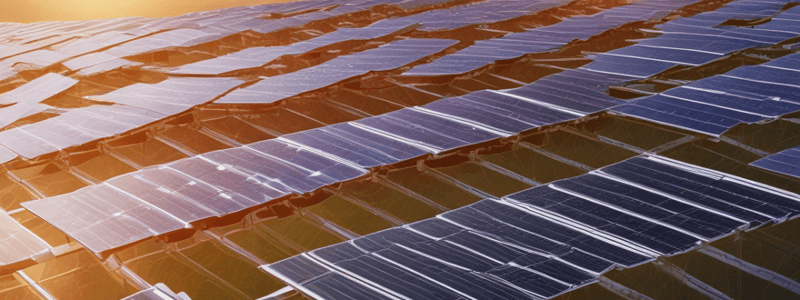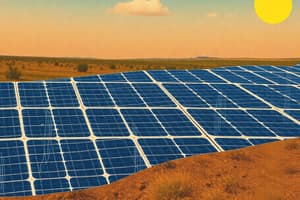Podcast
Questions and Answers
What is the primary function of a photovoltaic cell?
What is the primary function of a photovoltaic cell?
- To convert chemical energy into thermal energy
- To convert thermal energy into mechanical energy
- To convert electrical energy into light
- To convert light energy into electrical energy (correct)
What type of device is used to amplify the photoelectric current generated from converting light energy?
What type of device is used to amplify the photoelectric current generated from converting light energy?
- Phototransistor (correct)
- Photodiode
- LDR
- Solar panel
What is the characteristic of a photodiode that enables it to produce both voltage and current?
What is the characteristic of a photodiode that enables it to produce both voltage and current?
- P-N junction
- Light-sensitive exposed junction (correct)
- Forward bias
- Reverse bias
What happens to the resistance of an LDR when the amount of light falling on it changes?
What happens to the resistance of an LDR when the amount of light falling on it changes?
What is the primary application of a Hall Effect sensor?
What is the primary application of a Hall Effect sensor?
What is the characteristic of the light beam produced by a laser diode?
What is the characteristic of the light beam produced by a laser diode?
What is the primary function of a proximity sensor?
What is the primary function of a proximity sensor?
What determines the color of the laser light?
What determines the color of the laser light?
What is the effect of a magnetic field on a Hall Effect sensor?
What is the effect of a magnetic field on a Hall Effect sensor?
Which type of proximity sensor is useful for detecting metallic objects?
Which type of proximity sensor is useful for detecting metallic objects?
What type of radiation is used by some proximity sensors to detect objects?
What type of radiation is used by some proximity sensors to detect objects?
What is the function of a PIR sensor in security systems?
What is the function of a PIR sensor in security systems?
What is the difference between a laser diode and an LED?
What is the difference between a laser diode and an LED?
What type of proximity sensor detects objects by sensing changes in the magnetic field?
What type of proximity sensor detects objects by sensing changes in the magnetic field?
What is the primary advantage of capacitive proximity sensors?
What is the primary advantage of capacitive proximity sensors?
What is the primary function of RF diodes?
What is the primary function of RF diodes?
What is the main application of chemical transducers?
What is the main application of chemical transducers?
What is the main application of electromechanical gas sensors?
What is the main application of electromechanical gas sensors?
What is the purpose of a humidity sensor?
What is the purpose of a humidity sensor?
What is the primary function of a Turbidity Sensor?
What is the primary function of a Turbidity Sensor?
What is the unit of measurement for salinity?
What is the unit of measurement for salinity?
What is the principle behind the Electrode type salinity sensor?
What is the principle behind the Electrode type salinity sensor?
What is the definition of turbidity?
What is the definition of turbidity?
What is the purpose of a Turbidity Sensor?
What is the purpose of a Turbidity Sensor?
What is the characteristic of water that is measured by a Turbidity Sensor?
What is the characteristic of water that is measured by a Turbidity Sensor?
Flashcards are hidden until you start studying
Study Notes
Photovoltaic Cell (Solar Cell)
- Converts light into electrical energy
- Photovoltaic effect: sunlight photons knock electrons loose from atoms, generating electricity
- Reduces carbon footprint by harnessing solar energy
- Applications: solar panels, solar-powered chargers, solar street lighting
Photodiode
- Converts photons into electrical current
- Has a similar structure to a normal PN junction diode
- Produces both voltage and current
- Mainly used in solar cells to power electrical equipment from solar energy
Phototransistor
- Amplifies photoelectric current generated from converting light energy
- Has a similar structure to a transistor except for a light-sensitive base region
- Connected only in forward bias, requires a power source to operate
- Generates current only, mainly used for detecting or sensing light intensity
LDR (Light Dependent Resistor)
- A tiny light-sensing device also known as a photoresistor
- Resistance changes as the amount of light falling on it changes
- Works on the principle of photoconductivity
Laser
- An acronym for "light amplification by stimulated emission of radiation"
- Converts electrical energy into light through stimulated emission
- Functions similarly to a regular p-n junction but is optimized for light generation
- Produces a concentrated, coherent light beam
PIR (Passive Infrared) Sensor
- An electronic sensor used in motion detectors
- Triggers lighting devices and protection systems
- Measures devices emitting infrared light in their field of view
- Detects the presence of people or animals through the heat emitted by their bodies
Hall Effect Sensor
- Transducer that varies its output voltage in response to a magnetic field
- Used for proximity switching, positioning, speed detection, and current sensing applications
- Uses a thin semiconductor with a continuous current
- Deflects charge carriers (electrons and holes) to the sides of the semiconductor, creating a Hall voltage
Proximity Sensor
- A non-contact sensor that detects the presence of an object
- Depending on the type, uses sound, light, infrared radiation (IR), or electromagnetic fields
- Used in phones, recycling plants, self-driving cars, anti-aircraft systems, and assembly lines
Inductive Proximity Sensor
- Detects metallic objects using the electrical principle of inductance
- A fluctuating current induces an electromotive force (EMF) in a target object
Optical Proximity Sensor
- Includes a light source and a sensor that detects the light
- Detects objects directly in front of them by detecting the sensor's own transmitted light reflected back from an object's surface
Capacitive Proximity Sensor
- Can detect both metallic and non-metallic targets in powder, granulate, liquid, and solid form
- Uses the variance in the capacitance of the sensor to conclude that an object has been detected
Magnetic Proximity Sensor
- Detects the presence of a magnetic object
- Sense the presence of a magnetic object, characterized by its magnetic field, triggers the switching process
RF Diode
- Specialized components engineered to manage high-power radio frequency (RF) signals
- Crucial for efficiently controlling and manipulating RF signals, ensuring optimal performance and signal integrity
- Designed to handle high-frequency signals efficiently
Chemical Transducers
- Essential tools that transform chemical information into signals
- Used in food safety, industrial process control, medical diagnostics, and environmental monitoring
Gas Sensors
- Devices that detect the presence or concentration of gases in the atmosphere
- Electromechanical Gas Sensor: an electrochemical cell that quantitatively detects a particular chemical species
Soil Moisture Sensor
- Measures the volumetric water content in the soil
- Sensor mainly utilizes capacitance to gauge the water content of the soil
- Interacts with the water molecules in the soil and changes its capacitance value depending on the amount of water
Humidity Sensor / Hygrometer
- Sensitive electronic devices used to measure the air's humidity
- Divided into two categories: relative humidity sensors and absolute humidity sensors
- Capacitive Humidity Sensor: measures the dielectric material's change in electrical permittivity
- Resistive Humidity Sensor: detects humidity changes by measuring changes in the material's resistivity value
Turbidity Sensor
- Used to quantify the amount of total dissolved/suspended solids in a solution
- Measures the particle concentration and purity of a solution, such as water
- Turbidity is the measure of relative clarity of a liquid
Salinity Sensor
- Used to determine the concentration or refractive index of saline solution by weight
- Measures the conductivity of a solution with a high ion concentration
- Electrode type salinity sensor: operates by immersing two electrodes in the solution, measuring the current flow, and converting it into a salinity value
Studying That Suits You
Use AI to generate personalized quizzes and flashcards to suit your learning preferences.




